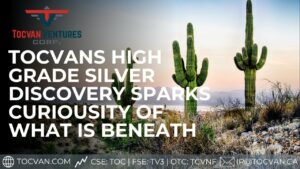Excalibur Resources Ltd. (“Excalibur” or the “Company”) is pleased to announce it has filed a 43-101 Technical Report on the Catanava Gold Property on SEDAR www.sedar.com. The following is an excerpt of the Interpretation and Conclusions section of the report, prepared by Mining Insights Inc.
Excalibur Resources Ltd. is the 49% owner of Minera Catanava S.A. de C.V., which has constructed a gravity gold/silver plant to produce gold and silver from the Catanava Gold Project, located in the historic Pinos gold/silver camp of eastern Zacatecas State, Republic of Mexico.
The Catanava Gold Project is an arc-related low-sulphidation epithermal vein system consisting of a series of gold-silver veins occupying extensional fractures and normal faults oriented north-south and northeast-southwest. See www.excaliburresources.ca/i/pdf/CatanavaMap.pdf Veins at Catanava are hosted within a sequence of limestones and limy sediments of the Mesozoic Cuesta del Cura Formation.
Veins consist of silica-cemented breccia, silica, and calcite, with inclusions of fault breccia. Vein textures include vugs, banding, and chalcedonic silica after platy calcite. Vein alteration includes indeterminate clays with intense hematite and minor jarosite as fracture coatings within the vein with limited alteration on the hanging wall and footwall of the vein. Gold mineralization is found as metallic flakes unevenly distributed in quartz in veins; silver and gold mineralization is postulated to be sulphide-based in grey, grainy aggregates scattered throughout the clear and chalcedonic quartz phase of the veins (Guapo and Infantita in particular) called ‘ginguro’ mineralization.
Data Verification surface sampling returned values up to 15.15 g/t gold and 160.7 g/t silver in a sample of Guapo Vein surface muck with ginguro mineralization. Underground sampling returned values up to 7.58 g/t gold and 55 g/t silver in an intensely hematite altered zone of the Tanous vein at the limit of historical development. Minera Catanava has installed a 150 tonne per day mill outside the Catanava Gold Project, on lands owned and controlled by Minera Catanava 51% joint venture partner Minera Apolo S.A. de C.V. Gold and silver are to be produced by gravitational separation followed by a form of sluicing known as the Micron Mill Wave Table. There are no reserves or resources at the Catanava Gold Project; nor any mine plans, nor any current exploration, so no estimate can be made of potential gold and silver production. However, planned throughput will come from a combination of dumps, stockpiles and existing historic underground development.
Recommendation:
The Technical Report recommends a two-phase sampling and mapping program for the Catanava Gold Property with a budget of approximately $94,500. First, all historic Romarco Minerals drill holes that cut the vein systems on the Catanava Gold Property are to be resampled within the vein zones, and within the hangingwall and footwall alteration zones. All accessible underground workings are to be resampled and structurally mapped, as well as surface structure and alteration on the entire Catanava Gold Property. PIMA analysis is recommended for clays in alteration zones to determine the presence of illite-smectite high-temperature assemblages, which could be indicators of higher-grade gold and silver mineralization nearby. As well, geometallurgical and petrographic studies are recommended to determine mineral suites in gangue and ginguro assemblages.
Excalibur’s Chairman, Mr. Tim Gallagher, commented, “The filing of the 43-101 non-resource report is a key step in the TSXV application process and the goal to increase our profile. The gold and silver mineralization in the Pinos District is self-evident, given the extensive historical workings dating to 1546 including 50 shafts, 7 Cornish chimneys, 2 large water tanks, mapping of up to 100km of veins and various small miners in the period 1930s to 1960s. However, despite the extensive sampling and some drilling by various groups (Bethlehem Steel/ Penoles(1975-81), Hecla Mining Corp (1996-7) and Romarco Minerals Ltd (2006-7), a resource has not been established. Hence, the strategy of building a plant to process ‘bulk samples’ in order to more accurately represent the grade, as well as establish the potential of the Pinos Gold District. Moreover, with a high gold and silver price environment and a low Mexican cost base, it makes imminent sense to focus on mining with a traditional approach ie small simple, low-impact, low capex, in relatively shallow high grade brownfield project. Finally, once we have some production statistics, in combination with some drilling, we hope to produce a PEA as a producing entity.”
James S. Steel, B.Sc. MBA P.Geo. is a “Qualified Person” for the purpose of National Instrument 43-101, and has reviewed and verified the contents of this news release.
Excalibur Resources Ltd. is a junior exploration mining company focused on the discovery, development and mining of economically viable precious and base metal mineral resources.
The CNSX has neither approved nor disapproved of the contents of this press release.
On behalf of the Board of Directors:
“Tim Gallagher”
Chairman
For more information please contact:
Tel: 416-987-0298
Email: [email protected]
Website: www.excaliburresources.ca
Maza Drilling is a Mexican company established in 2007 in Mazatlán, Sinaloa. Our Canadian founder, Mr. Guy de Launiere, has over 20 years of international experience managing diverse drilling operations. Maza Drilling strives to compete at the highest levels in terms of recovery, effectiveness, efficiency, and affordability at every project while keeping at the forefront of technology to meet our customer’s needs in this demanding market.
























